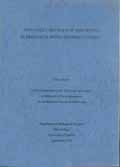| Thesis |
 |
|
| Title | The Safety-net role of tree roots in hedgerow intercropping systems | | Author | Edwin C Rowe | | Year | 1999 | | Academic Departement, University | University of London | | City | Wye, UK | | Number of Pages | 288 | | Departement | Biological Sciences | | Degree | PhD | | Call Number | TD0081-04 | | Keywords | Safety-net, Tree-roots, Hedgerow, Intercropping Systems |
|
| Abstract: |
| The leaching of nitrogen constrains the development of sustainable agricultural systems in the humid tropics, particularly where crop root growth is restricted by subsoil toxicity. Trees in fields will improve nitrogen use efficiency if these trees it actively take up leached nitrogen from deep soil layers: the safety - net hypothesis. This hypothesis was tested within hedgerow intercropping systems on an Ultisol in Lampung, Indonesia. The location of root uptake activity was determined using 15 N enriched ammonium sulphate applied to the soil, and related to root distributions studied using coring and wet extraction. The native tree Pellophorum dasyrrachis was found to have a higher proportion of roots in the subsoil than the introduced tree species Gliricidia sepium. The area-weighted mean vertical angle of tree main roots were found to indicate fine root vertical distribution, providing a quick method for assessing root distribution complementarity in agroforestry trees. The ratio of 15 N uptake from.- deep placements to 15N uptake from shallow placements was correspondingly larger in Peltophorum than in Gliricidia. Over 175 days, Gliricidia took up an estimated 21 kg N ha7 I and Peltophorum an estimated 42 kg N ha-1 -from beneath the main crop rooting zone. Gliricidia roots were coincident with roots of a maize intercrop, and maize yield was reduced by intercropping with Gliricidia. N use efficiency, determined after surface applications of 15N urea, was reduced in the Gliricidia intercrop since competition reduced crop uptake. Temporal processes are critical to safety-net function. Maize took up 15N from 15N placements at 65 cm depth only from around 60 to around 90 days after sowing. While competition is likely to occur in intimately mixed agroforestry associations, this can be minimised by using trees which regrow slowly or are pruned regularly during the growth of the crop. Benefits of N interception and recycling by trees will still occur if trees grow well during any fallow periods in the cropping cycle. Tree N uptake can be regulated by shoot pruning; trees took up little 15 N from applications at any depth for 2 weeks after pruning. Downslope hedgerows recovered around twice as much urea - 15N as upslope hedgerows, demonstrating the importance of lateral leaching. 15 N applied as labelled tree prunings appeared not to be susceptible to this effect. Mineral isation and uptake by maize of N were greater from Gliricidia prunings than for Peltophorum prunings; this 6ffect was related to the smaller N content and greater protein binding capacity of the Peltophorum prunings. Experiments were simulated using a dynamic model of water, light and nutrient interactions in agroforestry, WaNuLCAS, which was parameterised using root distribution data, tree, crop and soil characteristics. Predictions of tree and crop yield were reasonably accurate. The model was used to explore optimal hedgerow pruning time and safety-net layer characteristics for intercrop yield and safety-net function. An iterative fractal model was used to simulate total root system length and rooting intensity from measurements of root branching characteristics. |
|